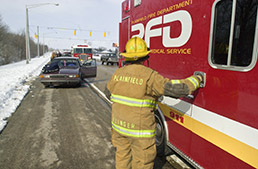Subscriber Benefit
As a subscriber you can listen to articles at work, in the car, or while you work out. Subscribe NowHoosier women are more dangerous when driving on wet roads.
Older men struggle on snowy and ice-covered roads.
And young men are dangerous on dry pavement.
Now there’s some fodder for holiday party conversations—based on findings of a Purdue University study of Indiana drivers.
Fred Mannering, a professor of civil engineering, analyzed 2007-2008 police reports involving 23,431 Hoosier drivers who crashed.
 Men over age 45 are 5-1/2 times more likely to be severely injured or killed when driving on snowy and icy roads than on wet roads. (IBJ File Photo)
Men over age 45 are 5-1/2 times more likely to be severely injured or killed when driving on snowy and icy roads than on wet roads. (IBJ File Photo)Among his findings, men over age 45 are 5-1/2 times more likely to be severely injured or killed when driving on snowy and icy roads than when driving on wet roads.
Put that same older man in a pickup truck and watch out—that group was 81 percent more likely to be injured than older men driving other vehicles (Buicks and such).
“This could reflect overconfidence or a false sense of safety in such vehicles, which are generally larger,” Mannering said.
Women can stop feeling smug. Women age 45-and-up are four times more likely to be severely injured on wet roads than when driving on dry surfaces; younger women nearly three times more likely.
“This suggests that women drivers, on average, significantly underestimate the risk of a severe crash on wet roads and do not compensate for reduced friction on slick, high-speed roads,” Mannering said.
At least the oldsters can blame their crashes on the weather.
Younger men, on the other hand, had a 21-percent higher likelihood of getting banged up while driving on dry roads. These machismo morons had a 72-percent higher likelihood of severe injury on a dry road than on snowy or icy roads.
Younger men may be “tempering” some of their aggressive driving behavior to compensate for the compromised roadway surface under adverse weather conditions, Mannering said.
“But they seem to let such behavior loose on dry roads and may be underestimating the severe crash risk in good weather conditions.”
Please enable JavaScript to view this content.
